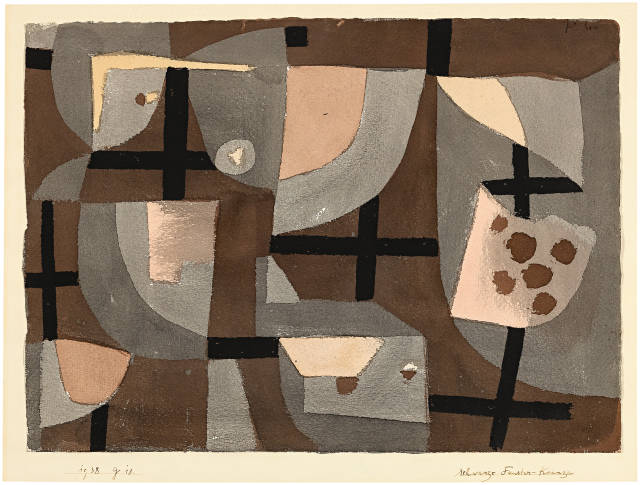- FR
S’inscrire
- Acheter
- Vendre
- Plus
- Galerie
- Commerce d'art
- Maison d'Édition
- Kornfeld aujourd’hui
- L'histoire de la Maison
- Informations



Münchenbuchsee bei Bern 1879 - 1940 Muralto
1938 - work number 1938.98 (G 18)
Watercolour and pencil on paper monted on cardboard
28.5x39.2 cm, image (irregular); 41.2x52 cm, cardboard
Signed "Klee" in ink by the artist upper right, dated and with the work number "1938 G 18" on the support above the final stroke lower left, titled "schwarze Fenster-Kreuze" on the right
Paul Klee Foundation, Catalogue raisonné, vol. 7, Works 1934-1938, Bern 2003, No. 7299
Daniel-Henry Kahnweiler, Galerie Simon, Paris (until 1939)
Karl Nierendorf, Cologne/Berlin/New York (from 1939)
Ackerman Collection
Auction Sotheby's Parke Bernet & Co, London, 3 December 1980, lot 157
Valentien Gallery, Stuttgart (until 1992)
Auction Galerie Kornfeld, Bern, 26 June 1992, lot 63, purchased there by
Private collection Switzerland
Karl Nierendorf, Paul Klee, Paintings, Watercolours 1913 to 1939, New York 1941, ill. tf. 52 (Black Window Frames / 1937)
Galerie Valentien (ed.), Art of the 20th Century, stock catalogue 1986/87, Stuttgart 1986, ill. p. 35
Wolfgang Kersten, Paul Klee, Through the Window, 1932, in: From Liotard to Le Corbusier, 200 Years of Swiss Painting, 1730-1930, exhibition catalogue, High Museum of Art, Atlanta 1988, p. 172, fig. 63a
Cambridge 1940, Germanic Museum, Harvard University, Oils and Watercolors by Paul Klee (without catalogue)
With slight lightstruck on the backing cardboard and traces of an old mounting. In overall good condition and fresh in colour
Already severely affected by his illness, Paul Klee continued to work intensively in the last years of his life. This late work is characterised by a generous formal language, two-dimensional compositions and a reduced colour palette. After a period of stagnation in 1935/1936, a final highly productive creative phase began in 1937, despite major limitations due to the increasing hardening of his skin. He continued to explore the dramatic political changes in the world, as well as his deteriorating state of health, particularly through his images of suffering figures or symbolic signs.
Are the "Schwarzen Fenster-Kreuze" perhaps a combination of these themes or even a premonition? Shortly before the watercolour offered here, he created "Demarkation" (Catalogue Raisonné 7297). In this inconspicuous drawing Klee may be alluding to the "Anschluss" of Austria to the German Reich. The "Fensterkreuze", on the other hand, are reminiscent of (military) cemeteries, here still partially covered by curtains, or of barred, cage-like windows through which one cannot escape. The watercolour, painted in subtle shades of brown, could thus become one of those works in which Klee interweaves his personal fate with the fate of the world, demonstratingonce again his incomparable sensory abilities and the bold pictorial power of his art.
1938 - Werknummer 1938.98 (G 18)
Aquarell und Bleistift auf Papier, auf Karton aufgelegt
28,5x39,2 cm, Darstellung (unregelmässig); 41,2x52 cm, Unterlagekarton
Oben rechts vom Künstler in Tusche signiert "Klee", auf Unterlage über Abschlussstrich unten links datiert und mit der Werknummer "1938 G 18", rechts betitelt "schwarze Fenster-Kreuze"
Paul Klee Stiftung, Catalogue raisonné, Band 7, Werke 1934-1938, Bern 2003,
Daniel-Henry Kahnweiler, Galerie Simon, Paris (bis 1939)
Karl Nierendorf, Köln/Berlin/New York (ab 1939)
Slg. Ackerman
Auktion Sotheby's Parke Bernet & Co, London, 3. Dezember 1980, Los 157
Galerie Valentien, Stuttgart (bis 1992)
Auktion Galerie Kornfeld, Bern, 26. Juni 1992, Los 63, dort angekauft von
Privatsammlung Schweiz
Karl Nierendorf, Paul Klee, Paintings, Watercolors 1913 to 1939, New York 1941, Abb. Tf. 52 (Black Window Frames / 1937)
Galerie Valentien (Hrsg.), Kunst des 20. Jahrhunderts, Lagerkatalog 1986/87, Stuttgart 1986,
Wolfgang Kersten, Paul Klee, Through the Window, 1932, in: From Liotard to Le Corbusier, 200 Years of Swiss Painting, 1730-1930, Ausstellungskatalog, High Museum of Art, Atlanta 1988,
Cambridge 1940, Germanic Museum, Harvard University, Oils and Watercolors by Paul Klee (ohne Katalog)
Mit leichtem Lichtrand auf dem Unterlagekarton und Spuren alter Montierung. Sauber und farbfrisch in der Erhaltung
Schon stark von seiner schweren Krankheit gezeichnet, arbeitete Paul Klee in den letzten Lebensjahren intensiv weiter. Charakteristisch sind die grosszügige Formensprache, die flächigen Kompositionen und die reduzierte Farbpalette. Trotz grosser Einschränkungen durch die zunehmende Verhärtung seiner Haut setzte nach einer Stagnation in den Jahren 1935/1936 ab 1937 eine letzte sehr produktive Schaffensphase ein. Dabei thematisierte er immer wieder einerseits die sich politisch dramatisch verändernde Welt, andererseits aber auch seinen sich verschlechternden Gesundheitszustand, namentlich durch die Darstellungen leidender Figuren oder symbolhafter Zeichen.
Sind die "Schwarzen Fenster-Kreuze" vielleicht als Kombination der Themen oder gar als Vorahnung zu verstehen? Kurz vor dem hier angebotenen Aquarell entstand "Demarkation" (Cat. Rais. 7297). In dieser unscheinbaren Zeichnung könnte Klee auf den "Anschluss" Österreichs an das Deutsche Reich anspielen. Die "Fensterkreuze" wiederum gemahnen an (Soldaten-)Friedhöfe, hier noch teilweise durch Vorhänge verdeckt, oder auch an vergitterte, käfigartige Fenster, durch die man nicht ausbrechen kann. Das dezent in Brauntönen gemalte Aquarell könnte so zu einem jener Werke werden, in denen Klee sein persönliches Schicksal mit dem Schicksal der Welt verwebt, und damit einmal mehr sein unvergleichliches Sensorium und die kühne Bildmacht seiner Kunst eindrücklich unter Beweis stellt.
| Suisse | CHF | 170 |
| Europe | CHF | 270 |
| USA | CHF | 360 |
| Outre-mer | CHF | 380 |




